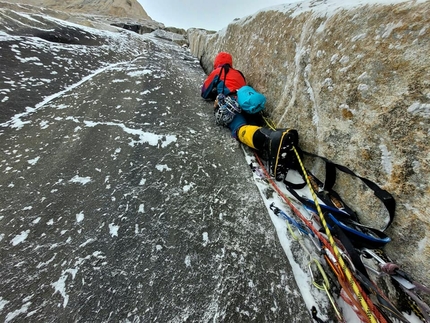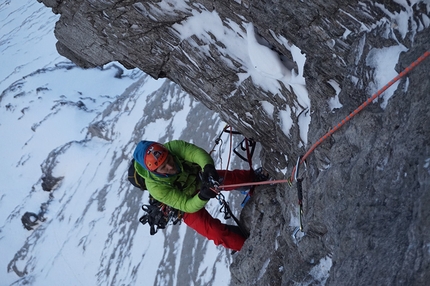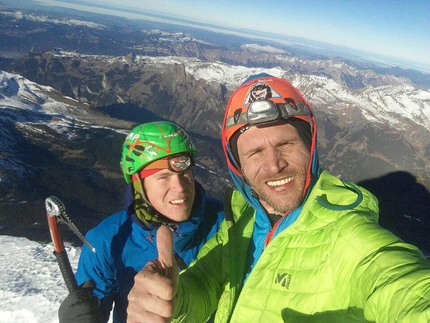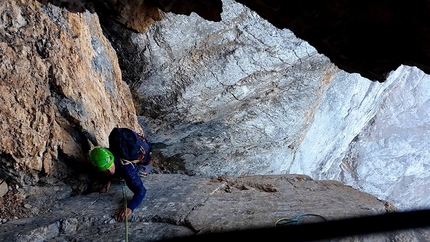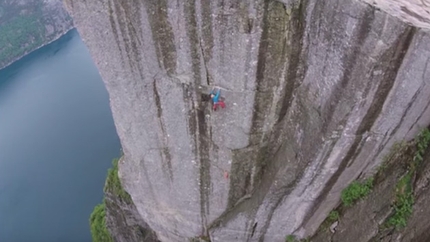First ascent of Oqatssut Wall in Greenland by Paweł Hałdaś, Marcin Tomaszewski
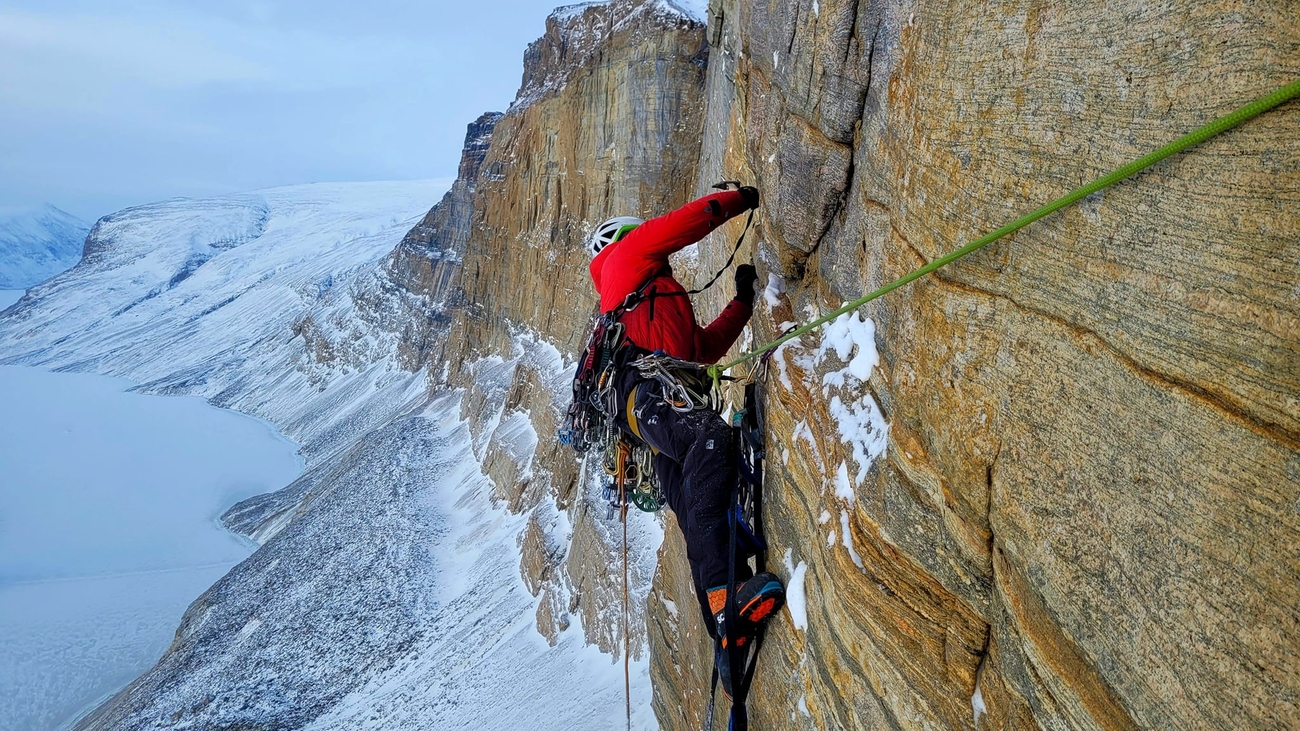
 1 / 38
1 / 38 Marcin Tomaszewski / Paweł Hałdaś
Marcin Tomaszewski / Paweł Hałdaś
My carefully thought out expedition with Pawel Haldas began with a complete change of plans. The tactics we had envisaged and the areas we were going to explore for our walls landed in the trash the moment after arrival. Ice cover on the fjords is never constant, it is influenced both by the air temperature and by the wind pushing warm water from the Baffin Sea into its depths, which in turn melts ice cover down to zero. This is precisely what happened near our would-be walls on Storoen Island, on Uummannaq and Agpat Island, and a local guide advised us against travelling to those areas.
We realised that the key to success case was speed, especially as the weather conditions and particularly the temperature in Greenland varies enormously in winter. After arriving in the village by helicopter on our second day, thanks to the help of the extremely helpful local Inuit people - in particular Anton - we set off on a reconnaissance trip into the fjords and towards the permafrost. Talking to local hunters, we had learned about the existence of rock walls of unknown size and shape that they had passed during their hunting expeditions. We really wanted to get a close look at them and this was made possible thanks to their snowmobiles. The local fishermen's knowledge of the state of the ice cover came in handy. On that day we saw plenty of interesting alpine-type massifs, something I’d describe as a real climbing Eldorado and, above all, a beautiful exposed rock wall about 6 kilometres wide and of unknown height. The decision was made in silence as we both immediately fell in love with this piece of frozen rock.
On the 9th February we pitched our tents on the surface of the fjord, pinning them to the ice with screws. We got ice for cooking from the nearby ice floe since both the snow and the surface of the fjord were salty. The next day we packed our gear and headed for the wall. And so our adventure began.
It took us a total of 14 days to establish the route. We fixed the lower parts of the exposed wall in good weather, but as it turned out a while later, the sun in Greenland also brings with it very low temperatures. During the first days of action we experienced temperatures of about -40 °C. As we soon discovered, the locals add a few more degrees to the forecast temperatures due to the proximity of the cooling air off the ice cap.
Our primary concern throughout the climb was out battle against the cold. After the first few days of action and one day during which we decided to wait out a frost wave (-41 °C or lower, rare even in this region), we fixed part of the wall up to the portaledge bivouac site. The climbing in the lower section of the wall was not difficult technically, but nevertheless very demanding due to the loose rock and specific rock formations. Indeed, in this area, sedimentary, metamorphic rock prevails. The black bands cross the wall at two levels, resulting in poorer quality granite and a high risk of falling rock. Due to the loose rock, at the anchors, we decided to place 12mm bolts for the rappelling and hauling.
The short 7-hour day meant that we were unable to complete more than one or two pitches a day, and these were added either by aid climbing or free climbing up to M5. Climbing at night was out of the question due to the prohibitive conditions and temperatures.
We both agreed that the priorities were not to get frostbite, not to cool down beyond the acceptable limit and to complete the route even if this would require more days than originally planned. Throughout the ascent we were constantly on the verge of getting frostbite on toes and hands, which every now and then lost feeling and turned white. Even just a moment's carelessness would have ended our expedition and our dream of a new route on this beautiful wall.
We had spotted the line of the route almost immediately and Paweł and I completely agreed on what route to take . It stretched along a line of natural formations with a few question marks. I love them so much... As it turned out later, the only change to our envisaged line came at the top, where we had a choice between two big exit corners. Unable to decide, we climbed straight up the middle, between them! In fact, they proved too gloomy, brittle and full of loose slabs. In between them, we had spotted some beautiful orange rock features, and these proved a good choice!
On the 18th of February we set off up the wall for good. We deliberately did not bivouac low down in order to avoid damaging our bivy with falling rock. We hauled our haulbags, which we then hung on the bivouac together with the portaledge just above the 9th pitch. There was a good ledge there with snow for melting water. The weather, despite the low temperatures and wind, was good, so we tried to make the most of every day and forge a further few metres up the wall. Nevertheless we progressed very slowly, even tediously, with the cold being our biggest enemy. After a moment's rest, the body cools down, losing heat from the fingers which then require warming up again and again. This takes time!
Every day we took turns leading. The leader wore light clothes and moved all day, whereas the belayer wore his warmest clothes, down jackets and trousers, in order to survive a day on the wall.
On the climb we breached several chimneys and overhangs that were too wide for our #6 cams, forcing us to do some real acrobatics and produce some “black climbing magic”. After passing the second strip of black rock, Paweł pushed on to the demanding A3 pitch. I could hear the flakes reverberate, see thin slabs stuck to the wall while standing directly underneath them! I felt like a man condemned to the guillotine! "For what sins?” I silently thought to myself. Well I know, there have been some…
We decided to use some bat hooks to reach safer formations. This pitch took Paul a good couple of hours, climbed in silence, in terrible winds and through spindrift. He was extremely brave, I was proud of him. As we later learnt, thanks to this progress we received the best possible prize: we now had the chance to reach the summit the next day, the last day of acceptable weather before the forecast thaw and strong winds up to 110 km/h. Back at the portaledge, just like every evening, we slowly took off our boots, melted snow for tea and freeze-dried food, then crawled into our sleeping bags where we warmed up ever so slowly. Thanks to the Polish company Pajak, we had double sets of sleeping bags: artificial on the outside, and down on the inside. The insulating and self-drying properties of these sets worked perfectly. We’d fall asleep after 9 p.m, and wake-up at 5. Outside, as Paweł says, lurked the stinging EVIL. But THAT day was amazing and greeted us with a rich reward: windless and seemingly even warmer than usual. I accelerated and quickly led two long and exposed A1/C1 pitches to the top of the wall. It was beautiful! On reaching the top of the wall we untied and after another few dozen metres of scrambling we stood on the summit. The ice floes way down below us trapped in the frozen fjord looked insane, one seemed to remind us of the FRAM ship that may have once been below our wall? It's hard to describe what we felt, what we saw! This moment collected many brief fragments from the past days, months and even rest of our lives. It is impossible to describe fully, so let me leave this moment just to myself.
Having descended to the bivouac, we prepared all our gear for the rappels the next day. The forecast from our InReach messenger was not optimistic. Time began to playing a major role, as around 1pm winds of about 110 km/h were forecast, along with high temperatures that could lock us up in this icyice trap for days. Fortunately, we managed to descend in time and at 12 o'clock we reached the camp where Anton picked us up a short while later. An hour after reaching the village of Uummannaq, the road across the fjord closed, the ice cracked and began to turn into a thick soup. In the evening the wind hit with full force. We just cannot imagine what would have happened had we not made it back in time… Indeed, when we reached base camp a few hours earlier, we’d noticed how our tents were pitched in this melting ice pulp.
Today, 26 February, there is water under the walls of Storoen and in many places the fjord has melted completely. In a few days it will probably freeze again. The thought keeps running through my mind that just one day slower could have resulted in us being cut off from the world for longer than we would have liked. We were extremely lucky.
The Oqatssut (a local name) rock wall is quite brittle, and we imagine that it could still prove quite risky in summer. However, it deserves close attention as there is potential for numerous interesting new lines. We'll be reliving our wonderful adventure for a long time, I'm sure you'll hear a few more stories from us. All I can say now is that we’re glad to have made our big dream come true.
We wish to thank many people and brands. We were not there alone but with you. With your firm support! Slawek Ejsmond you were supposed to be here with us as a climbing partner, unfortunately important matters kept you at home. Thank you for helping us complete all the preparations. Our loved ones experienced a lot, thank you for understanding something that cannot be understood, only… felt. Many of you kept your fingers crossed for us and sent good energy, you are the best!
In the future we will write more about this place, as it is worth exploring this area in both summer and winter. We recommend staying at Uummannaq, as well as cottages and the AVANI hostel run by Anton, who took care of us during this trip. A great guy, you can count on him. Thank you very much for supporting our expedition!
Finally, a huge shout-out from me to my Italian CAMP family that manufactures the equipment for this type of rock climbing. Thanks to you, I felt prepared, safe in terms of equipment and finances. In addition to the gear, good energy, filled with passion for the mountains and kindness, flowed to me from your factory in Premana!
Below you will find a very important list of brands that have supported us. Take a look please, they stand behind people like us and it is thanks to them that we can continue to discover the world. We recommend each and every one of them, because they have real people standing behind them.
Last but not least, Paweł, thanks for climbing together. We did it!
Marcin Yeti Tomaszewski
Thanks to: CAMP 1889 - Outdoor, Boreal, Bezpieczny Powrót, Polski Himalaizm Sportowy, Polski Związek Alpinizmu, Fundacja Wspierania Alpinizmu Polskiego im. Jerzego Kukuczki, The Explorers Club - Oddział Polski, Tabor Pod Krzywą, Taternik Kwartalnik, Wrocławski Klub Wysokogórski, Big Wall - Centrum Wspinaczkowe, Fundacja START, PAJAK, Marabut, Szczeciński Klub Wysokogórski, Big Wall Gear, #d4, Avani
New line: FRAM, 700 m, 17 wyc. M5, A3, C2, VI
First ascent: 10-24/02/2023
First Winter Big Wall in Greenland.



 Copia link
Copia link
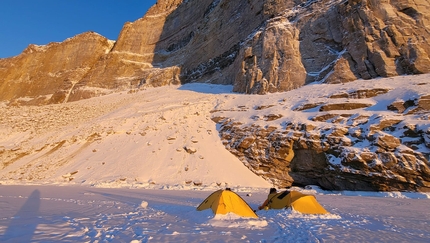
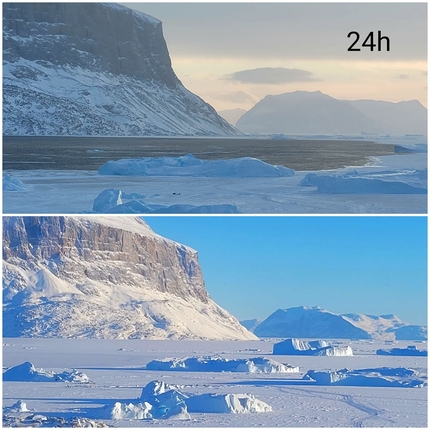
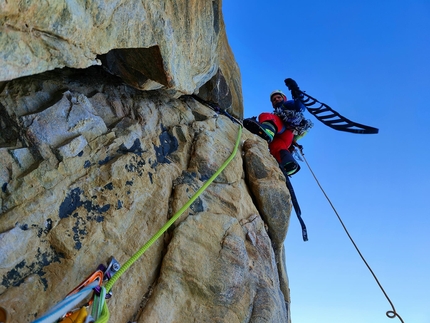
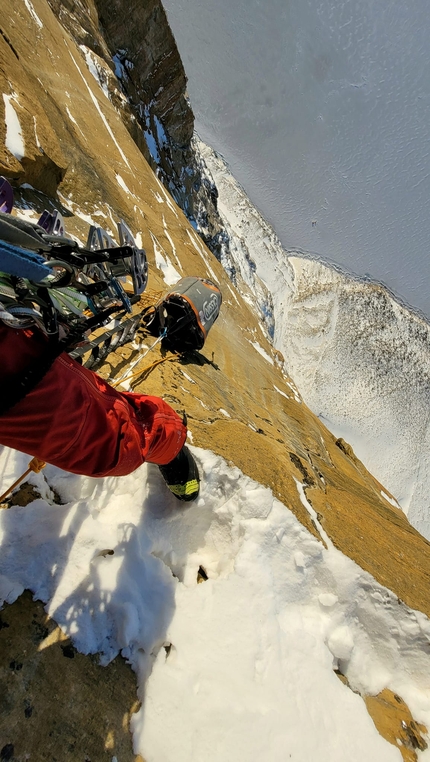
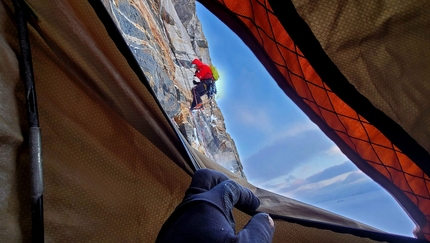
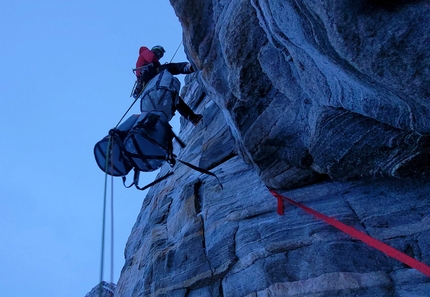
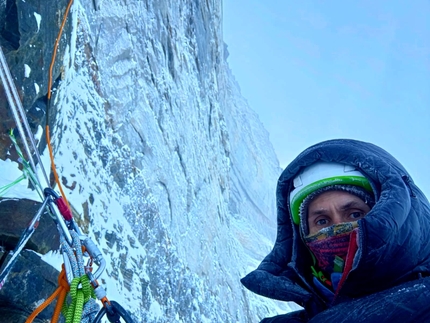
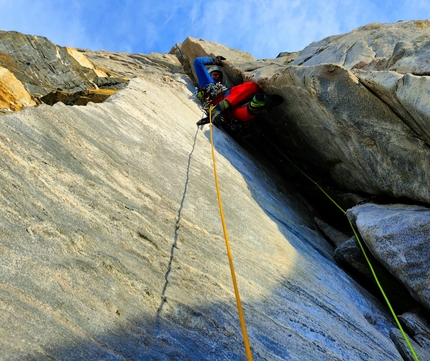
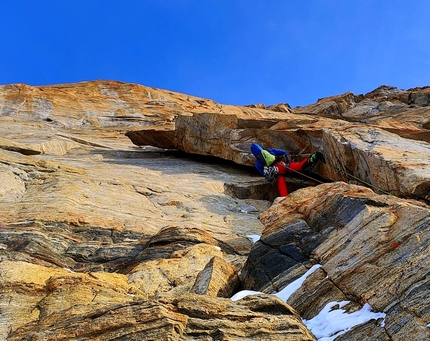
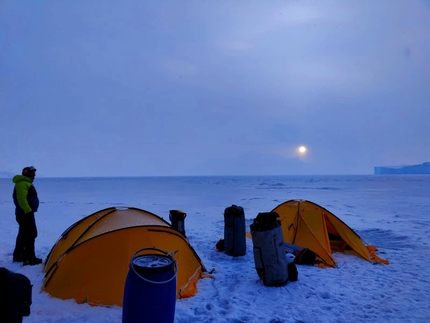
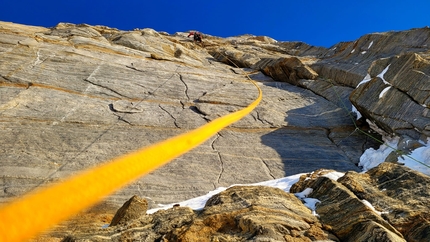
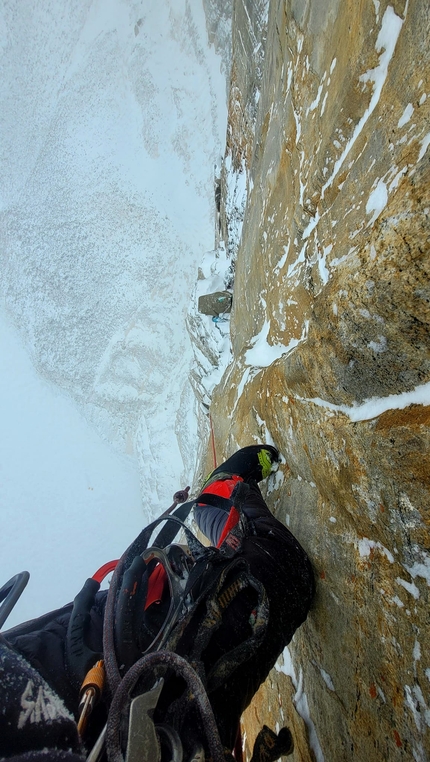
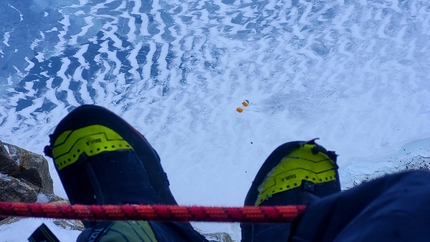
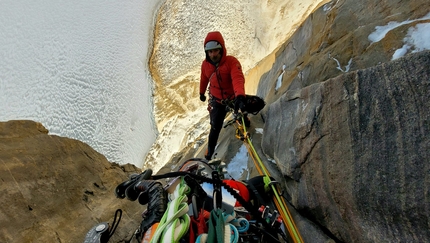
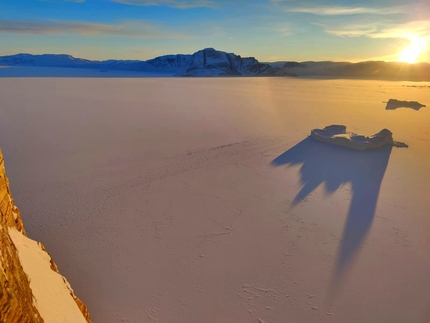
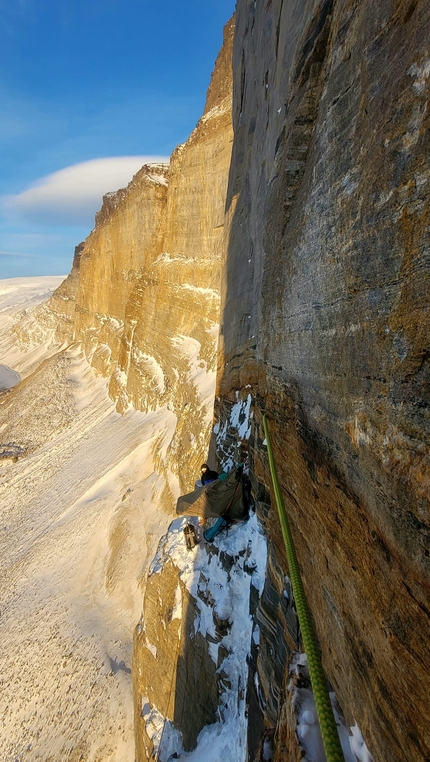
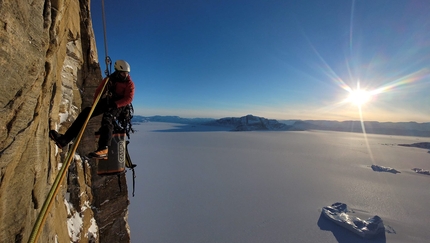
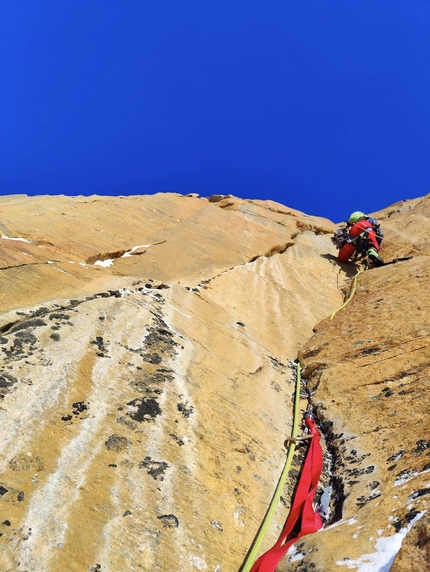
 See all photos
See all photos